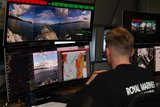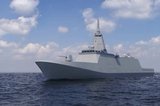Raytheon demonstrates Tomahawk re-targeting
The Tomahawk Block IV cruise missile has successfully demonstrated new capabilities in a test conducted by the US Navy and Raytheon, the company announced on 5 October.
The tests were undertaken to demonstrate that the missile's strike controllers, located at multiple fleet headquarters, can control and redirect multiple missiles simultaneously.
During the test, the missile took a reconnaissance photo and followed orders to re-target in mid-flight. It was launched from a guided missile destroyer USS Gridley (DDG 101). The missile used its onboard camera to capture battle damage indication imagery and transmitted the image to fleet headquarters through its two-way UHF SATCOM datalink. The missile then entered a loiter pattern to await further instructions.
The missile was retargeted with a new aim point on the navy's range at San Nicolas Island, off the coast of southern California, by the strike controllers at the US Fifth Fleet headquarters in Bahrain. The missile performed a vertical dive and struck the designated target.
To reduce testing costs, only one missile was put through a live launch demonstration; the rest were flown via computer simulation through various missions directed by forward deployed strike controllers.
Dave Adams, senior program director, Raytheon Tomahawk, said ‘We have once again proven the flexibility and utility of the Tomahawk Block IV missile, which has an unprecedented record of reliability and combat success.
‘Tomahawk continues to be the weapon of choice for combatant commanders requiring very long range, precision strike, with the flexibility to loiter and re-direct after launch. No other weapon has this capability.’
More from Naval Warfare
-
![NATO tests use of “undetectable, jam-proof” laser communication in maritime scenarios]()
NATO tests use of “undetectable, jam-proof” laser communication in maritime scenarios
As part of its effort to better prepare its capabilities for operations in contested and congested scenarios, NATO evaluated a Lithuanian ship-to-ship terminal designed to not be susceptible to enemy interference.
-
![US Navy advances with the Harpoon Service Life Extension Programme]()
US Navy advances with the Harpoon Service Life Extension Programme
The US Navy plans to improve Harpoon’s anti-ship and land attack capabilities by equipping the missiles with sensors and technologies required for succeeding in future battlespace.
-
![Mitsubishi eyes future with Australia’s Mogami selection]()
Mitsubishi eyes future with Australia’s Mogami selection
With Australia’s selection of the Mogami-class for Project Sea 3000, Mitsubishi is investigating local production in the next decade as potential export opportunities emerge.
-
![Thales’ new Sonar 76Nano could equip UK Royal Navy on anti-submarine warfare missions]()
Thales’ new Sonar 76Nano could equip UK Royal Navy on anti-submarine warfare missions
The new sonar is designed to equip uncrewed underwater vessels, with the potential to be used by the Royal Navy for its Atlantic Bastion and Atlantic Net missions.
-
![Hanwha wins Australian government approval to increase its stake in Austal]()
Hanwha wins Australian government approval to increase its stake in Austal
The contract would mean the two shipbuilders can collaborate strategically and enhance shipbuilding capabilities in Western Australia.























